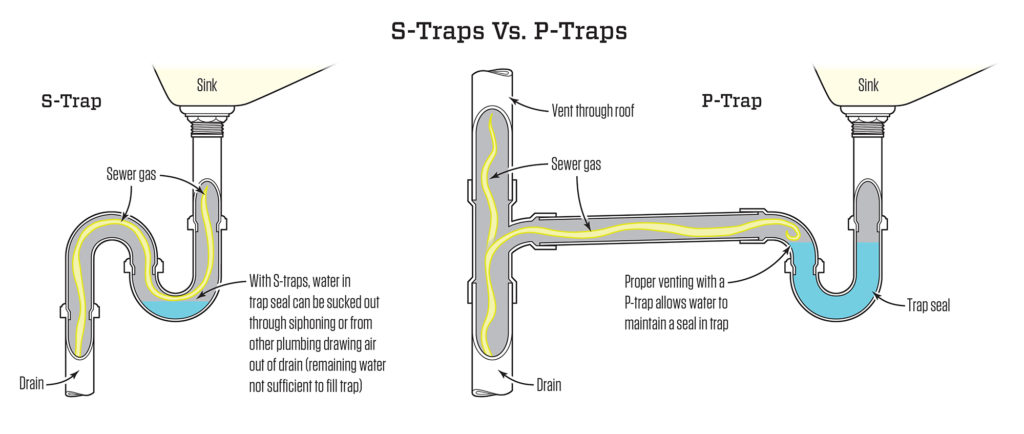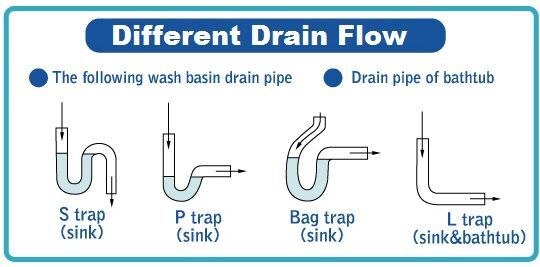S-trap is one of the two pipes that break the sewage flow in an S shape. The letter S-traps are found in plumbing systems that utilize gravity flow. They are primarily used in homes with a basement; however, they can also be found in apartment buildings. The s-trap is a plumbing device below the drain of a sink or toilet and is attached to the vertical pipe. It is designed to trap gasses produced inside the drain (that are lighter than water) as well as any odor and gasses released by wastewater. S-trap aims to prevent sewer gasses from coming up through the drain and into your house or office. It also prevents any potential sewer odors from filling up your bathroom.
On the other hand a p-trap is a plumbing device used to form a seal between the drain pipe and the sewer line. A p-trap can be made of various materials but will typically be composed of a U or S shaped bend in the pipe. The p-trap is placed below the high water mark so that no standing water can enter into it and it retains water in the vertical section. The P-trap was originally designed by a man named Thomas Crapper, who was an English inventor and entrepreneur who went on to design what we now know as the modern toilet.
What’s The Difference Between S-trap And P-trap?
P-trap, also called a P valve, is a plumbing device that diverts water from drain to waste pipes by gravity – or when water pressure decreases. S-trap is a plumbing device that catches gasses from sewage systems, such as methane and hydrogen sulfide before releasing them into the atmosphere. The S-trap is more expensive and complicated than the P-trap. However, it has less surface area and catches more water which is why it’s used to pump water from lower levels.

The S-trap is a plumbing system consisting of a vertical pipe that connects to the drain, with a slope going downwards, and an offset horizontal pipe connecting to the ground level sewer connection. The headwater created by this design causes wastewater to flow down the slope into the bottom horizontal pipe, where it will ultimately flow into the ground-level sewer connection.
S-traps rely on water pressure to open so it doesn’t pose too much of a problem if there is no water pressure or slow draining in the sink or shower in other parts of the house.
The S-trap and P-trap are both fixtures in a plumbing system, but each function is different.
The P-trap is designed to seal off the drain pipe when it meets the floor. On the other hand, the S-trap is used to seal off any water that might escape from a sink or other fixture downstream from the trap. However, it does not provide protection for wastewater that might be present in a bathtub or shower so consider adding another trap as well as an overflow drain.
P-Trap VS S-Trap Toilet:
The S-trap and P-trap have the same function, but they do it differently. To decide which is better, one should consider whether one wants a high-performance toilet or a more eco-friendly toilet.The P-trap toilet is higher performing than the S-trap toilet because it uses water differently than the latter. The P-trap works by pulling water into the drain and holding it there until you flush it, while the S-trap works by holding water in an open seal until you flush it.
The main difference between these toilets is treating the incoming water before putting it down the drain. The P-trap gathers up all of its incoming water, while the S-trap leaves some of it behind in an open seal.
S-traps and P-traps are a part of the waste vent system for your home.The difference between s and P-traps can be confusing if you haven’t had much experience with them before, but they are both important parts of how plumbing functions in homes.
Swamp or The P-trap is Better For A Bathroom Sink?
This is a question which has been answered differently over time. The P-trap or the S-trap both have their own advantages. While one is easier to access, the other reduces water waste by trapping it in pipes. Both of these traps can be used interchangeably in most cases. This is a question of opinion. However, the P-trap is more common than the S-trap in the US and Canada.

S-Trap VS P-Trap Kitchen Sink:
We can use a trap to catch any water or other fluids not meant to be in the basin or the drain. P-traps are typically used in kitchens as they can handle cold water. In contrast, S-traps are more suited for bathrooms because they can only handle warm water.
An S-trap is most commonly found in bathrooms, as it features a more gentle slope than that of its counterpart, the P-trap. An S-trap aims to prevent sewer gasses from entering into your home and causing odors.
S-traps and P-traps are both used for sewage drainage. However, they have different uses, so it is important to know their difference when using them in a kitchen sink or washroom.
As the name suggests, S-traps work like a siphon: water flows in one end and will flow out the other end in a continuous loop.
P-traps have an extra waste pipe that empties into the main sewage line. This lets gravity do most heavy lifting and ensure that everything flows down and not up.
Most modern homes use both types of drains: they would have an S-trap near their kitchen sink or bathroom sink and a P-trap nearer to the toilet.
Entering the installation of an S-trap requires ripping open plywood on the floor, cutting through sheet metal, and plunging one’s arm into a grimy sewer line.
Why is S-Trap Not Allowed?
The most obvious reason S-traps are not allowed is that they are difficult and dangerous to maintain. The S-trap is not allowed because it has a tendency to be a slip hazard. The S-trap has a vertical opening above the liquid which can cause liquids to fall into the S-trap and create an overflow when they are full. The UPC Code prohibits the use of any “S” trap that could permit sewage gasses to come out of a fixture or appliance,
The Uniform Plumbing Code (UPC) requires that all plumbing be installed in compliance with the code. For example, the UPC prohibits an “S” trap from being used under a sink if it can release sewer gas into the room. As long as there is no ventilation on this type of install, sewage gas will not dissipate and could create a potential health hazard to occupants.
Why Are S-Traps No Longer Used?
The design of the S-trap has not changed since the nineteenth century and is due for an update.
The S-trap is a drain that uses gravity to pull away water from a building. The design of this kind of trap has not been updated in nearly 200 years, but it is about time to take it out for some upgrades.
The S-trap is a plumbing pipe used to drain the water at the lowest point of a building. But, it is not commonly seen in new buildings because it had been replaced by the U-trap because of its inadequacies.
The S-trap can be found in old buildings, where they are installed because they are cheaper to install than the U-trap. The water enters from an S-shaped bend and then flows down through the vertical pipe with either a dip or an air vent to prevent sewer gas from entering. The problem with this type of trap is that if there is any corrosion, many leaks will form around this bend and cause more damage.
The main issue with the S-trap is that the water at the bottom of the S-trap may freeze during cold weather and then, when it melts, it will go back up and flood your basement.
What is The Difference Between S And P-Trap Toilets?
The difference between an S and P-trap toilet is the position of the water in the pipes. It’s important to understand how these toilets work to ensure that your system is working properly.
An S-trap toilet has a bend in its pipe that holds water in the top section, while a P-trap toilet has a bend at the bottom of its pipe. This means that when you flush an S-trap toilet, water goes into both sections and when you flush a P-trap toilet, water only goes into the bottom section.
A P-trap toilet is a type of toilet that has a trap on the side of the bowel. The S-trap toilet is a type of tankless toilet, which leaves no space where water can sit.
The P-trap design is one of the oldest methods for preventing sewer gasses from coming up through the drain pipe and into your bathroom. It consists of an “S” shaped pipe with a bend in it, which forms two chambers – one connected to the sink at one end and another connected to the drainpipe at another end.
You need to pump water through your bowl on an S-trap toilet by pushing down on a lever or foot pedal. However, some new models use electric suction motors instead.
If you still have questions regarding any confusion between these two or want to know if your home has plumbing systems or components that need upgrading, schedule an appointment with Hawley Home Inspections llc. We are the experts for all your plumbing, septic or sewer problems

